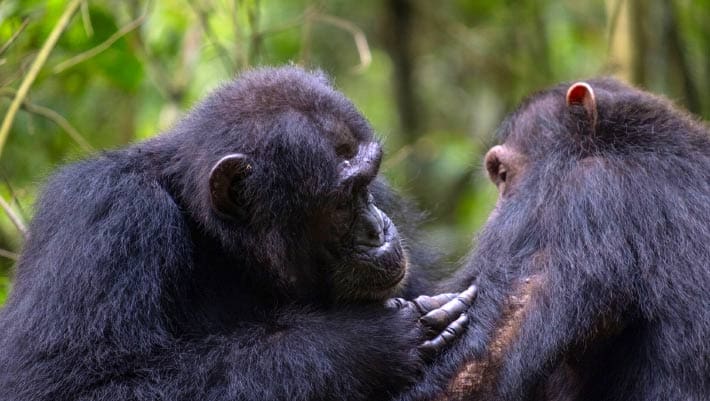Primatologists have documented and analyzed both previously reported and newly observed instances of self-directed and other-directed wound care, snare removal, and putatively medicinal hygiene behaviors in the Sonso and Waibira chimpanzee communities of the Budongo Forest in Uganda. They’ve observed self-directed wound care behaviors such as wound licking, leaf-dabbing, pressing fingers to wounds, and the application of chewed plant material to wounds, as well as a successful self-directed snare removal. They’ve also documented self-directed hygiene behaviors including postcoital genital leaf wiping and post-defecation leaf wiping.

Social grooming between two chimpanzees in the Budongo Forest, Uganda. Image credit: Elodie Freymann.
“Our research helps illuminate the evolutionary roots of human medicine and healthcare systems,” said study’s first author Dr. Elodie Freymann, a researcher at the University of Oxford.
“By documenting how chimpanzees identify and utilize medicinal plants and provide care to others, we gain insight into the cognitive and social foundations of human healthcare behaviors.”
Dr. Freymann and colleagues studied two communities of chimpanzees in the Budongo Forest: Sonso and Waibira.
Like all chimpanzees, members of these communities are vulnerable to injuries, whether caused by fights, accidents, or snares set by humans.
About 40% of all individuals in Sonso have been seen with snare injuries.
The researchers spent four months observing each community, as well as drawing on video evidence from the Great Ape Dictionary database, logbooks containing decades of observational data, and a survey of other scientists who had witnessed chimpanzees treating illness or injury.
Any plants chimpanzees were seen using for external care were identified; several turned out to have chemical properties which could improve wound healing and relevant traditional medicine uses.
During their direct observational periods, the scientists recorded 12 injuries in Sonso, all of which were likely caused by within-group conflicts.
In Waibira, five chimpanzees were injured — one female by a snare, and four males in fights.
The researchers also identified more cases of care in Sonso than in Waibira.
“This likely stems from several factors, including possible differences in social hierarchy stability or greater observation opportunities in the more thoroughly habituated Sonso community,” Dr. Freymann said.
The scientists documented 41 cases of care overall: seven cases of care for others — prosocial care — and 34 cases of self-care.
These cases often included several different care behaviors, which might be treating different aspects of a wound, or might reflect a chimpanzee’s personal preferences.
“Chimpanzee wound care encompasses several techniques: direct wound licking, which removes debris and potentially applies antimicrobial compounds in saliva; finger licking followed by wound pressing; leaf-dabbing; and chewing plant materials and applying them directly to wounds,” Dr. Freymann said.
“All chimpanzees mentioned in our tables showed recovery from wounds, though of course we don’t know what the outcome would have been had they not done anything about their injuries.”
“We also documented hygiene behaviors, including the cleaning of genitals with leaves after mating and wiping the anus with leaves after defecation — practices that may help prevent infections.”
Of the seven instances of prosocial care, the authors found four cases of wound treatment, two cases of snare removal assistance, and one case where a chimpanzee helped another with hygiene.
Care wasn’t preferentially given by, or provided to, one sex or age group. On four occasions, care was given to genetically unrelated individuals.
“These behaviors add to the evidence from other sites that chimpanzees appear to recognize need or suffering in others and take deliberate action to alleviate it, even when there’s no direct genetic advantage,” Dr. Freymann said.
The team calls for more research into the social and ecological contexts in which care takes place, and which individuals give and receive care.
“Our study has a few methodological limitations,” Dr. Freymann said.
“The difference in habituation between the Sonso and Waibira communities creates an observation bias, particularly for rare behaviors like prosocial healthcare.”
“While we documented plants used in healthcare contexts, further pharmacological analyses are needed to confirm their specific medicinal properties and efficacy.”
“Also, the relative rarity of prosocial healthcare makes it challenging to identify patterns regarding when and why such care is provided or withheld.”
“These limitations highlight directions for future research in this emerging field.”
The study was published in the journal Frontiers in Ecology and Evolution.
_____
Elodie Freymann et al. 2025. Self-directed and prosocial wound care, snare removal, and hygiene behaviors amongst the Budongo chimpanzees. Front. Ecol. Evol 13; doi: 10.3389/fevo.2025.154092


